Thank you coaches for completing this survey. At this point we have 65+ coaches who have fully completed the survey and given some great feedback. This gives us a great summary and a wide variety of how coaches are getting it done with teaching offensive line techniques. It also shows us what many coaches are doing and if it’s something different, gives us some options in our teaching.
It’s still open and you can still TAKE IT HERE! All coaches who share will get a complete copy of results minus the names and schools of coaches who shared.
In this first part of our review of the Offensive Linemen Case Study, we will cover coaches feedback on how lineman stances are taught.
Shoulder Blocking Technique
The first question I used to lead into a review of stances was if they coached the shoulder blocking style (Crowther) of line blocking? Does this influence the way a coach teaches stances? So here’s a diagram of the results at the point of writing this article.
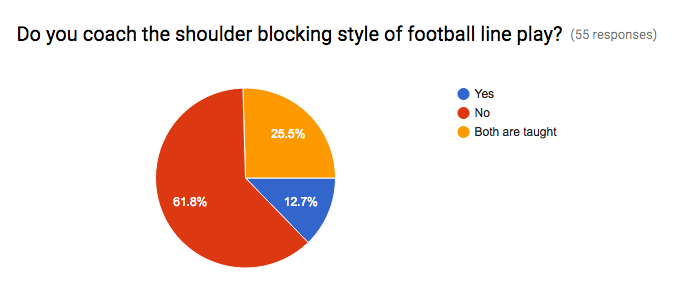 Within the coaches surveyed, the majority of coaches do not teach that technique exclusively. However, it is worth noting that a full 25.5% of coaches are teaching both techniques. Looking back at the correlation of style of offense these coaches are running, we find that the coaches who are teaching both styles are running a mix of zone and power run plays or are only running gap styled/power run plays. So teaching the shoulder blocking style is not exclusive to gap run teams. Coaches who have read or listened to the famous Howard Mudd, NFL Offensive Line coach, would know that he has only and always taught shoulder blocking. Sometimes what’s old becomes new again and teams can find success in either form of block or even a combination of blocking.
Within the coaches surveyed, the majority of coaches do not teach that technique exclusively. However, it is worth noting that a full 25.5% of coaches are teaching both techniques. Looking back at the correlation of style of offense these coaches are running, we find that the coaches who are teaching both styles are running a mix of zone and power run plays or are only running gap styled/power run plays. So teaching the shoulder blocking style is not exclusive to gap run teams. Coaches who have read or listened to the famous Howard Mudd, NFL Offensive Line coach, would know that he has only and always taught shoulder blocking. Sometimes what’s old becomes new again and teams can find success in either form of block or even a combination of blocking.
Out of curiosity, checking this against team records, just over 50% of these teams blocking using both techniques are winning half of their games or more. Some teams are even doing much better then that and have undefeated seasons at the time of writing this.
[RF_CONTEST contest=’3593′]
Stances
In the next question we asked coaches what their primary stance was that they coached. Here’s the data on this response.
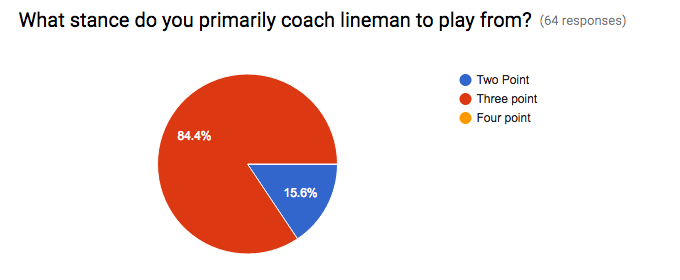 Not much surprise here that most coaches are teaching a three point stance. Again taking a look at stance vs. the preferred style of offense, there was a variety of offensive blocking schemes used when coaches taught two point stances.
Not much surprise here that most coaches are teaching a three point stance. Again taking a look at stance vs. the preferred style of offense, there was a variety of offensive blocking schemes used when coaches taught two point stances.
Two Point Stances
With coaches who taught the two point stance, most coaches identified their preference to have feet completely flat – totally balanced. A few coaches elaborated that they taught the LeCharles Bentley style of stance which is based on individual comfort and stability when pushed upon. You can find out more about his style in this great video on stance taught here:
One anonymous coaches comment on stance was, “I used to spend a tremendous amount of time coaching kids 3 point stance, knees bent etc. Now I just say “athletic stance” and expect kids to put themselves into a strong stance where I cannot push them over easily.”
This may or may not work for your players, so if you are looking for more specific keys to what this looks like, coach William Clay from Fossil Ridge High School, suggests a stance that has the “Inside foot up, back foot middle of front foot, this can change for pure pass pro. Feet should split the arm pit for width (the taller or longer the legs you can be a little wider). The depth of knee and angle of hip bend all depends on how well the athlete can move out of that stance. The most important thing is that they can step in any direction, can pull and move out of a comfortable stance. You can not coach a statue. We have their hands resting on the the thigh pads.
Common Problems With Two Point Stances
Within the two point stance, there appeared to be similar categories of problems that would occur. The first problem that was most commonly listed was players leaning in their stance. Leaning puts a two point stance of lineman off balance and makes it difficult to move in all directions. A common corrective drill for this was to physically push on players while they are in their stance to make sure that they are not leaning and are stable in all directions. See also the video below on finding the proper foot positioning in a stance.
Another common problem listed was feet too narrow or more specifically, knees not being inside the ankles. For best movement and stability, knees need to be inside the ankles. Jim McNally was the first coach I ever heard talk about this important alignment within offensive line movement. Here’s an old video that teaches about this technique. What is surprising is how long this key strategy has been out but how few coaches are actually teaching it.
A great way to keep the emphasis on this is with the duck walk drill where players move in 5yd segments taking short choppy steps keeping their toes out, knees inside ankles and pressing their instep into the ground with every step.
A final problem that was brought up and needed to be addressed by many coaches was bending at the waist too much and bowing ones back. The strongest position a lineman can be in is with his back flexed in a backwards bridge. Here’s is where a great strength and conditioning program is invaluable to your team. It’s very difficult to teach players to maintain their proper positioning when they have not been trained to perform lifts and exercises in those positions. If you find your players struggling with keeping their back in the proper position, it may be helpful to go back to the basics of the two point stance to reaffirm what it should look like.
Favorite Drills For Two Point Stance
The two primary drills shared by coaches for training stance are as follows:
Drill #1: Stance and Partner Push
In this drill, players get into a proper stance and partners will walk around and either push or pull their partner making sure their base is firm and balanced. This is not a drill to get carried away with, it’s just a simple quick check that by applying pressure, the player in his stance does not fall over. Before actually pushing on players by partners, coaches should first take some time to address each player individually making sure everything is correct. It may be necessary to physically manipulate each player into the proper position. Players can hear a correction but the awareness of their own positioning is not always correct.
Drill #2: Bird Dog
In the Bird Dog drill players start in their proper stance and then must take their first step out of their stance on a coaches command, but still maintaining the proper lineman positioning. Here’s a sample video of the drill (A disclaimer on this example is that there were few drills available freely that showed the drill and not all the stances in this example are ideal by any means).
Three Point Stance: Balance of Weight
With 84% of coaches preferring the three point stance, it is interesting how the preference for balance in a football stance changes to the majority preferring weight be slightly forward on hands and balls of feet. A smaller percentage also chose that their weight be mostly forward on hands.
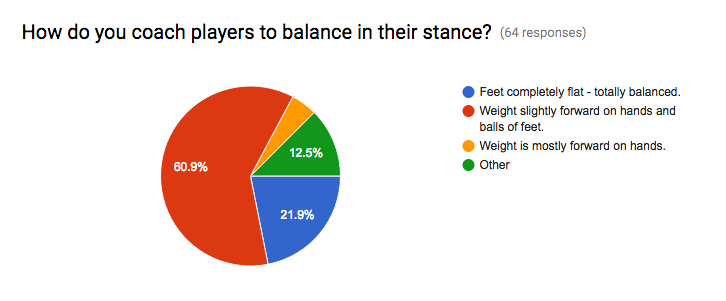 This would lead one to conclude that most coaches using a three point stance are prioritizing movement forward and less concerned with movement in lateral or drop back directions. It may also be a case of coaches telling players to adjust their stance if they are expected to move in these alternate directions. Adjusting a stance based on a play tends to show up on film and can possibly be a key to defenders on which play the offense is planning to run if they are away of this tendency.
This would lead one to conclude that most coaches using a three point stance are prioritizing movement forward and less concerned with movement in lateral or drop back directions. It may also be a case of coaches telling players to adjust their stance if they are expected to move in these alternate directions. Adjusting a stance based on a play tends to show up on film and can possibly be a key to defenders on which play the offense is planning to run if they are away of this tendency.
For coaches that keep three point stances balanced with very little weight forward on their hands, they do not have to change a stance to move differently.
So do you show your tendency to gain an advantage or do you hide all tendencies and work to be explosive in any direction is the question? By rule of majority, it seems most coaches would rather try to gain an advantage, even if it shows a tendency. This may also be due to a heavy run emphasis offensively. If a team throws the ball or makes frequent lateral moves more often it may make sense to be more balanced in their stance.
Here’s how each teams current record shows up based on the OL’s balanced stances. The point of this is to hopefully determine which of these factors may assist a team in performing better in the Win/Loss column. If you go by the belief that in HS and lower level of football, if you have a good line, you will have a good season, this could be very important.
Team Records Cumulative:
Weight mostly forward on hands – 18 Wins, 11 Losses
Weight balanced – 90 Wins, 52 Losses
Weight slightly forward – 61 Wins, 61 Losses
In every single category there were teams that were highly successful with undefeated seasons as well as teams that were struggling a lot with 0 or 1 win.
Shoulder Width Apart
Over 90% of coaches said they coached their players to start their stances at shoulder width apart. It is difficult to determine what this looks like exactly and if a little wider is still acceptable. A few coaches were much more specific and stated they were looking for armpit width. Here are a few coaches responses to get a better idea of how the entire stance is taught. Everyone phrases it a little differently but these different explanations seemed to characterize the differences the most.
One style is a wider more balanced stance:
Feet little more than shoulder width apart. outside foot back and toes lined with heel of inside foot turn out slightly at a 45 degree angle. Down hand placed on ground with 30% of weight on hand and 70% on inside balls of feet. Outside leg bent at 90* angle. Butt down head up. Back arched.
Another is a narrower, more forward leaning stance:
Toe to instep stagger. Align knees and toes forward. Feet shoulder width. Hips & head up, flat back. Heels off the ground with weight on our instep ball of the foot. Hand drops down underneath our eye with weight on our finger tips. Off hand is loaded and ready to strike in front of our face mask.
Finally, there is a narrower, more upright stance.
Squat to hand drop, balanced feet, flat back, eyes and mask up. Width is no more than shoulder width. Slightly tighter for pullers. Want to remain flat on initial surge. Slide up to waist and numbers as we drive.
Three Common Problems With Three Point Stances
There were three common problems that coaches identified when asked. The first problem was foot positioning. Coaches mentioned that their players either had their feet too wide or too narrow. As a simple fix, coaches would just walk around and have players move their feet to the correct position. Here’s an interesting video from LeCharles Bentley explaining where to put feet in a “where you feel good position.”
The second problem that coaches emphasized was players in their stances bending too much from the waist. A result of this was that their head was down and they couldn’t see the defense across from them. This problem is related to the previous problem because if your base is too narrow, it is going to be much harder to sink hips down enough to keep your head up and see across the line. Head up in a stance is a non-negotiable for safety’s sake.
The final problem category was that players would have too much weight distribution on their hands or forward. In a sense, players were lining up in more of a sprinters stance that a defensive lineman would use and have the inability to move easily in multiple directions. A simple fix coaches could implement here is to first have players work the two point stance or sit down in proper positioning before putting their hand down into the ground.
Drills for Three Point Stances
Here are some favorite drills described by coaches.
Three step progression. Each is controlled. Start with 1st step only, then do 2 step, then 3 step. Finally on full get off. Each step in each step is controlled by Coach and is done on cadence.
We call it sit and reset. Squat like a normal squat. Place thumb on the eye line. Reach hand out and tip forward.
Having them line up under the chute and firing out.
Squad stance drill – players in lines of 4 work pre set, snap down, 1st step – power step, 2 steps, 3 step to duck pound, repeat all angles and pulls.
Have them get in their stance, sit for 10-15 seconds, relax, back in stance.
3 step progression feet, drop butt sitting in chair, twist at the hips then dropping hand in front of the eye of the hand you are using.
Old school. Put them all in stances, walk around and pull their arm out from in front of them. If they fall, too much weight forward.
Jump till feet are wide enough, place arm on thigh, correct feet stagger, hand down.
A Proper Center Stance
Often overlooked, a Center’s stance will look different from other positions stances. One reason is because the center cannot have a foot back in the stance like a Guard or Tackle. So his feet have to be even or the snap will be affected. It’s important to make sure his stance is still functional and fits his bodies abilities. Wider then shoulder width stances give more support and allow a player to emphasize keeping knees inside ankles. Here’s another great video from LeCharles Bentley of the difference between a good center stance and a dysfunctional one.
Conclusion
With such a wide variety of coaching strategies for the common lineman stance, it is clear that even though coaches can be almost completely opposite in how they teach a stance, success can be found in each of the different paths. The balanced style of teaching stances with a focus on explosion through balance and applying forces in multiple directions has clearly spread throughout high school and youth programs. However, the more traditional forward leaning stances with narrower bases are still predominant. It will be interesting to see in the next section of the report how stances are matched up with splits and depth off the ball.
Determining which stance is better for a particular team or player should be defined by a coaches purpose and a clear understanding of the bio-mechanics of the stance. In the majority of High Schools and Youth Programs, the run game is king. Therefore, whatever stance is taught, it has to effectively put players in a great run blocking position that will result in a block that is held long enough to prevent the defense from tackling the ball carrier. If your team is struggling with maintaining blocks long enough, adjusting one’s philosophy on stance may be a good starting point to getting players more successful in accomplishing this task.
In our next report we will be discussing splits, depth off the Line of Scrimmage and first, second and following steps in the progression of a lineman block. Until then, thank you for reading and we would love to have you share this report with any other coaches you feel will benefit from reading it.
One Last Thing….
Join the discussion and comment below with any questions or additional ideas you have about lineman stances and what you have experienced. Growth happens best with great interaction!

![Case Study: Offensive Lineman Techniques [Part 1 Stances]](https://prostylespreadoffense.com/wp-content/uploads/2016/11/1473663338_801b0a29f2_z.jpg)
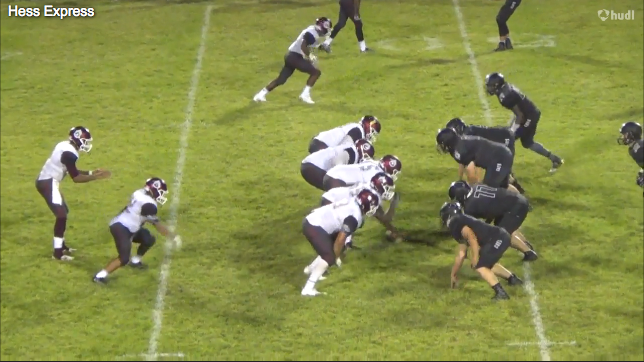
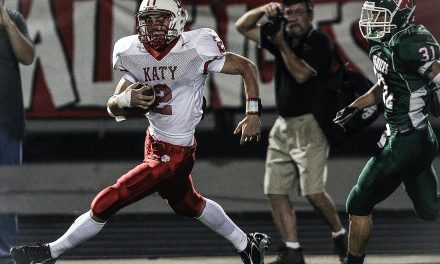
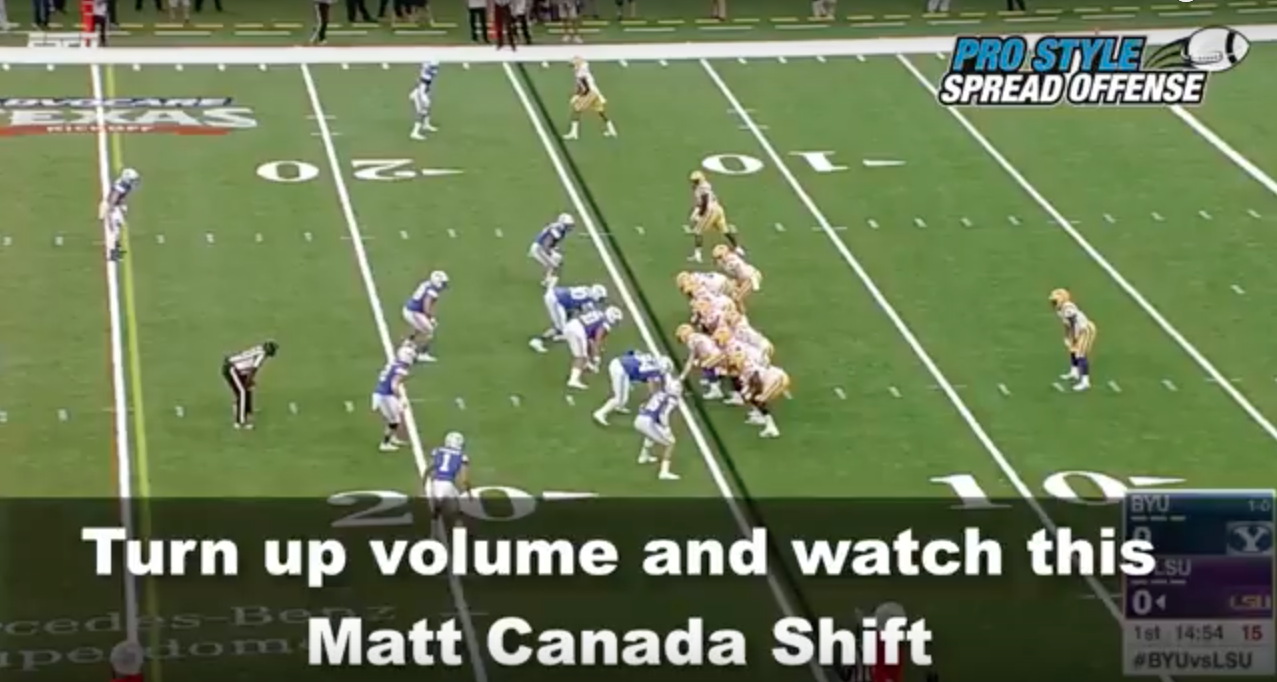
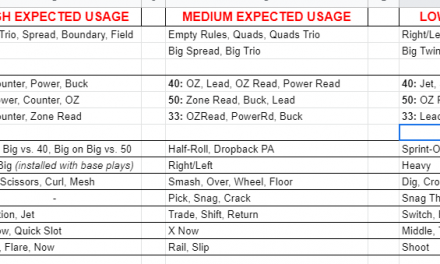
Good stuff.
I feel like linemen will be not be in a strong position after their first step in LeCharles Bentley taught stance. I like his teaching strong and balanced against pressure, obviously, but since linemen need to step to gain leverage and momentum, they need to be in a power position after their first and second steps. He knows his stuff, just a feeling I have about the width of his player’s stance in the first video.
Hey Greg, I do think he’s a little more focused on the dual run block/pass block ability of a lineman. Some offenses I don’t think have any kind of need for this balance and can be more run focused which in my mind puts them with more weight forward. It is interesting to see though how lots of coaches struggle with maintaining blocks – I think that comes from being less balanced and more weight forward. It’s kind of a catch 22…if you have more lean, it’s harder to maintain balance, but if you don’t have lean and attack, you have trouble getting the push you want.